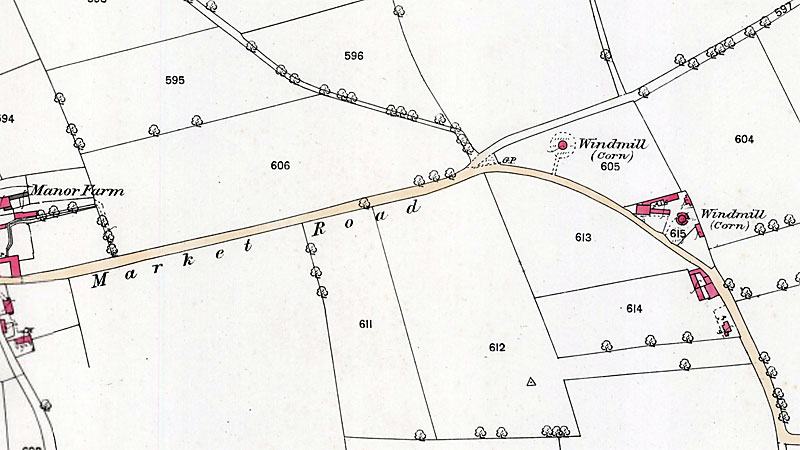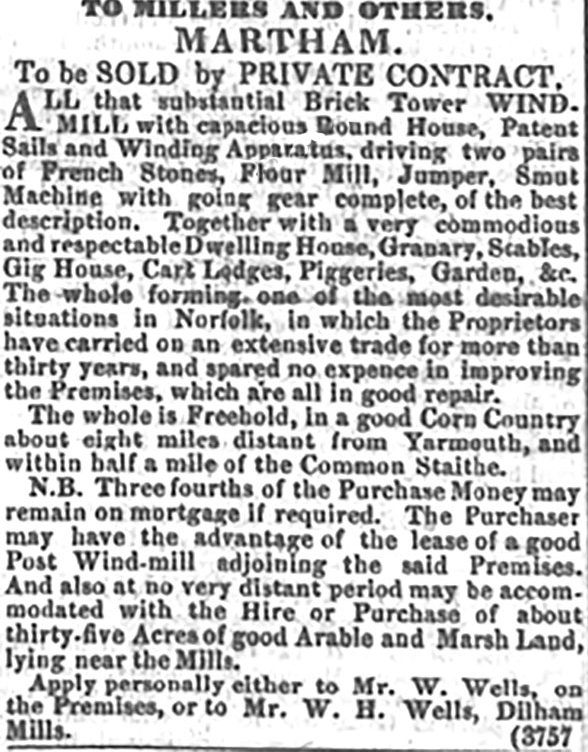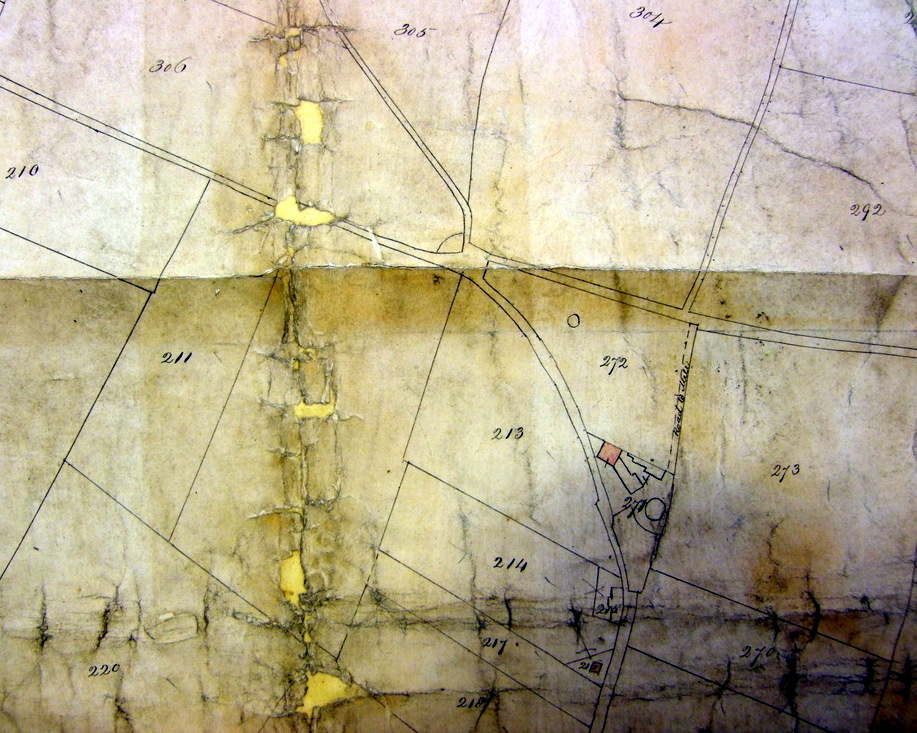William Wells Snr. (1771-1846) & William Harrison Wells (1805-1874). Millers of Martham.

There were two windmills at the top of Hemsby Road on the edge of the village as shown on the above map. At the time the map was drawn Hemsby Road was called Market Road.
One was a post mill which was severely damaged in a fire in 1789 and the second was a tower mill built a few hundred yards away to the south east. The miller was William Wells Snr. He was born in 1771 at Strumpshaw. By 1802 he was already at Martham as recorded in the West Flegg Poll List (Voters List). He married Sarah Harrison from Great Yarmouth on 29th January 1804. They had a son named William Harrison Wells who was born on 24th September 1805 and was baptised at St Mary’s, Martham on 29th of the same month. Later in life he went on to be a prolific mill owner but he learnt his trade at his father’s knee in Martham.
On 1st June 1811, the following advert was placed in the Norfolk Chronicle that confirms the miller was Mr W Wells. This would have been William Wells Snr.
“A steady active single man who understands working a tower mill and can read and write may hear of a place immediately by applying to Mr W Wells of Martham near Yarmouth, Norfolk.”
William Wells (Snr.) made a late claim to the land around the tower mill that appears on one of the maps prepared by the Commissioners responsible for managing the 1812 Inclosure Award.

Held in the Norwich Record Office Ref: CHC 11910 and BR 276/1/172.
Millers did not always have a good reputation. Despite being important to the local community they were often unpopular and considered to be cantankerous, mean-spirited, and sometimes guilty of cheating. A steady stream of millers were accused of adulterating flour with alum throughout the 19th century. Similar tales must have circulated in and around Martham and rumours spread to such an extent that William decided to publish the following proclaiming of his innocence in the Norfolk Chronicle on 20th May 1812:
“Whereas a malicious and unfounded report has lately been circulated, injurious to the character of Mr William Wells of Martham in the County of Norfolk, Miller, stating that he has adulterated his flour and been fined by the Magistrates for doing so; but knowing that he has not been guilty of the alleged circumstances he feels himself compelled to declare publicly they are false and without any foundation whatsoever and also that he will prosecute any person or persons with utmost rigour of the law, who may vilify and defame his character in the like manner, unjustly and undeservedly.”
The next reference we get to a Wells being a miller at Martham is in Robert Porters odd little book called “The Strangers Guide Book for the Polite Village of Martham”. The book was published around about 1830 and mentions Wells and Bane as being millers and includes a short verse in tribute to them:

Transcription: “Here Bane and Wells – two millers dwell of far farm’d notoriety. And if you’d plan – their Arts to scan. Pray entry their society. They are said to be – no more dissimilar. Than honesty and miller are.
Two millers so two mills, the tower mill was owned by William Wells Snr, and the other – a replacement for the original post mill that had been destroyed by fire was owned by James Bane the son of John Bane & Mary, nee Appleton. James Bane died in 1834 and made a Will that tells us he had previously let the mill to William Harrison Wells. So, both mills were then occupied by father and son.
The death of James Bane seems to have triggered a change of direction because both mills were put up for sale at the same time on 13th September 1834 with enquiries to William Snr. at Martham and William Jnr. at Dilham. This is the advert in the Norwich Mercury of 13th September 1834.

By 1842 Martham Tithe Award listed the tower mill as owned by William Snr but he had retired by this time and lived with his son who had taken over Dilham mill. The Martham mill was occupied by William Barnard Crowe who lived at the Mill House with his family.

William Wells Snr died in 1846 at Dilham and his wife Sarah in 1872 at Norwich.
William Harrison Wells (1805-1874)
William was born at Martham on 24th September 1805 and was given his mother’s maiden name as a middle name and grew up as the son of a miller learning his trade in the parish.
William married Harriet Rising Howes of the Rising/Howes family farming dynasty from West Somerton on 9th May 1832 at St Mary the Virgin, Martham. In 1834 he was mentioned in the Will of James Bane as the occupier of Martham Mill at Hemsby Road.
By 1841 William had moved with his family and become the miller at Dilham.
In January 1848 William bought Hellsdon Mill from Reverend Henry Berners of Woolverston Park, Suffolk and by June 1851 the mill and the mill house had been reconstructed and refitted over four water channels. It was 4 storeys high and built on a timber frame let into a brick base. It was huge and on the south side there were a total of 66 windows. The frame was cladded out with weatherboarding under a slate roof. William also built a whole complex on the site consisting of houses, cottages, warehouses, stables, drying kilns, blacksmith’s shops, carpenter’s shops and offices.
William lived there with his wife and seven children: John (16); Thomas (14); Raymond (11); Julian (10); Henry (8); Ellen (6) & Frederick (1). His widowed mother, Sarah, also lived there.
In 1861 William was also the miller at Crook’s Place, Heigham, Norwich where he employed 35 men and 1 boy. The family still lived at Hellesdon and included his wife Harriette (59); sons Thomas (23); Julian (20) and Frederick (11) plus daughters Ellen (16) and Rosalie (9) plus his mother Sarah (85).
By 1868 William was running New Mills and Crook’s Place mills but went bankrupt by 1870 as shown by this advert:
NOTICE IS HEREBY GIVEN, that WILLIAM HARRISON WELLS, of the City of Norwich, Flour Miller, has left in the Office of the Chief Registrar of the Court of Bankruptcy, Quality Court, Chancery Lane, London, a list of his Property and Credits, as required by the Bankruptcy Amendment Act, 1868.
Dated this 5th day of January, 1870;
WLLIAM SUTTON PAGE,
Guildhall Chambers, St. Peter’s Street, Norwich.
Solicitor for the Person Registering the Deed.
Norfolk Chronicle – 8th January 1870
In 1871 William lived with his family at Gildengate Street, Norwich. He was still listed as being a corn miller. He died on 31st December 1874 at Stoke Holy Cross formerly of St. George’s, Norwich, aged 69.
His sons took over parts of the business and were listed in Hamilton’s Directory of 1879 as millers at New Mills and the Tower Mill, Crook’s Place. John Robert Wells, born c.1835 and Frederick Rising Wells, born c.1850 were both sons of William Harrison Wells and were born while the family were living in Dilham. In 1881, Frederick Rising Wells was given as a miller and corn merchant living at 5, Heigham Road, Heigham with his wife Ellen (31), son Frederick (8) and daughter Lillian (7).
The Wells Brothers were listed in Eyre’s Directory of 1883 as millers in Essex Street and New Mills Yard. The tower mill was marked on the 1884 map. The Wells Brothers’ partnership was dissolved on December 1884.